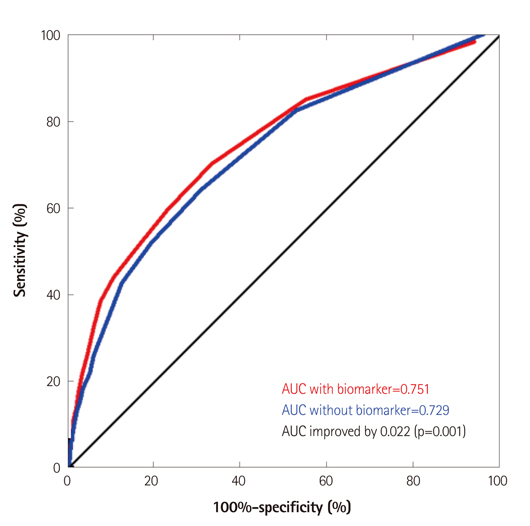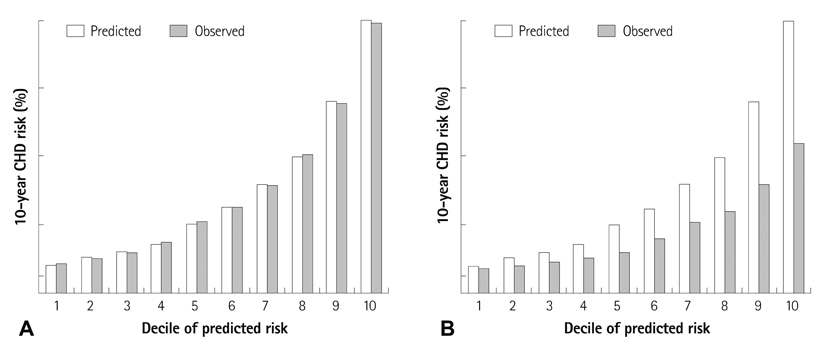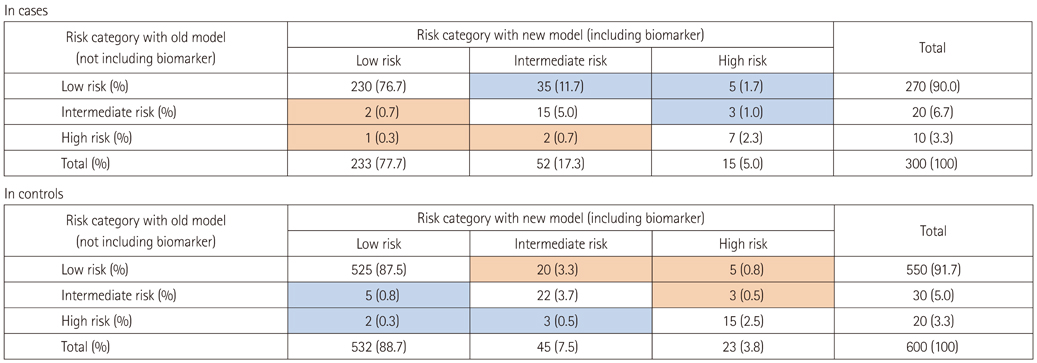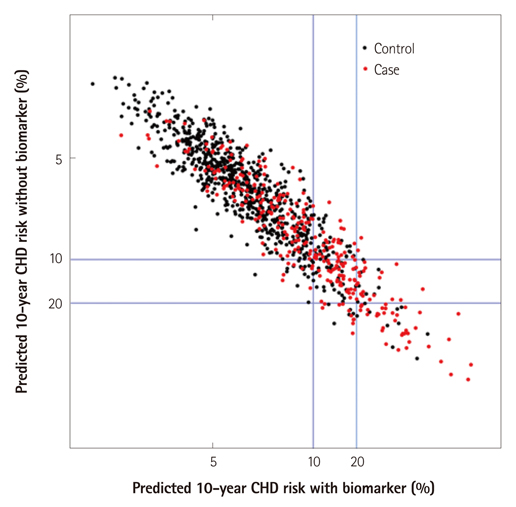Korean Circ J.
2012 Apr;42(4):223-228. 10.4070/kcj.2012.42.4.223.
Clinical Utility of Novel Biomarkers in the Prediction of Coronary Heart Disease
- Affiliations
-
- 1Department of Preventive Medicine, Division of Cardiology, Department of Internal Medicine, Yonsei University College of Medicine, Seoul, Korea. hckim@yuhs.ac
- 2Department of Preventive Medicine, Northwestern University Feinberg School of Medicine, Chicago, IL, USA.
- KMID: 2225013
- DOI: http://doi.org/10.4070/kcj.2012.42.4.223
Abstract
- Coronary heart disease (CHD) is a significant cause of morbidity and mortality worldwide. Many risk prediction models have been developed in an effort to assist clinicians in risk assessment and the prevention of CHD. However, it is unclear whether the existing CHD prediction tools can improve clinical performance, and recently, there has been a lot of effort being made to improve the accuracy of the prediction models. A large number of novel biomarkers have been identified to be associated with cardiovascular risk, and studied with the goal of improving the accuracy and clinical utility of CHD risk prediction. Yet, controversy still remains with regard to the utility of novel biomarkers in CHD risk assessment, and in finding the best statistical methods to assess the incremental value of the biomarkers. This article discusses the statistical approaches that can be used to evaluate the predictive values of new biomarkers, and reviews the clinical utility of novel biomarkers in CHD prediction, specifically in the Korean population.
MeSH Terms
Figure
Cited by 2 articles
-
A New Prognostic Tool for Korean Patients with Acute Myocardial Infarction
Hyeon Chang Kim
Korean Circ J. 2018;48(6):505-506. doi: 10.4070/kcj.2018.0127.Development and Application of Chronic Disease Risk Prediction Models
Sun Min Oh, Katherine M. Stefani, Hyeon Chang Kim
Yonsei Med J. 2014;55(4):853-860. doi: 10.3349/ymj.2014.55.4.853.
Reference
-
1. Lloyd-Jones DM. Cardiovascular risk prediction: basic concepts, current status, and future directions. Circulation. 2010. 121:1768–1777.2. Kim HC, Greenland P, Rossouw JE, et al. Multimarker prediction of coronary heart disease risk: the Women's Health Initiative. J Am Coll Cardiol. 2010. 55:2080–2091.3. Wood AM, Greenland P. Evaluating the prognostic value of new cardiovascular biomarkers. Dis Markers. 2009. 26:199–207.4. Wilson PW, D'Agostino RB, Levy D, Belanger AM, Silbershatz H, Kannel WB. Prediction of coronary heart disease using risk factor categories. Circulation. 1998. 97:1837–1847.5. National Cholesterol Education Program (NCEP) Expert Panel on Detection, Evaluation, and Treatment of High Blood Cholesterol in Adults (adult treatment panel III). Third report of the National Cholesterol Education Program (NCEP) expert panel on detection, evaluation, and treatment of high blood cholesterol in adults (adult treatment panel III) final report. Circulation. 2002. 106:3143–3421.6. Wood D, De Backer G, Faergeman O, Graham I, Mancia G, Pyörälä K. Prevention of coronary heart disease in clinical practice: recommendations of the Second Joint Task Force of European and other Societies on Coronary Prevention. Atherosclerosis. 1998. 140:199–270.7. De Backer G, Ambrosioni E, Borch-Johnsen K, et al. European guidelines on cardiovascular disease prevention in clinical practice: Third Joint Task Force of European and other Societies on Cardiovascular Disease Prevention in Clinical Practice (constituted by representatives of eight societies and by invited experts). Atherosclerosis. 2004. 173:381–391.8. Grundy SM, Cleeman JI, Merz CN, et al. Implications of recent clinical trials for the National Cholesterol Education Program Adult Treatment Panel III guidelines. J Am Coll Cardiol. 2004. 44:720–732.9. D'Agostino RB Sr, Grundy S, Sullivan LM, Wilson P. CHD Risk Prediction Group. Validation of the Framingham coronary heart disease prediction scores: results of a multiple ethnic groups investigation. JAMA. 2001. 286:180–187.10. Sheridan SL, Crespo E. Does the routine use of global coronary heart disease risk scores translate into clinical benefits or harms? A systematic review of the literature. BMC Health Serv Res. 2008. 8:60.11. Cushman M, Lemaitre RN, Kuller LH, et al. Fibrinolytic activation markers predict myocardial infarction in the elderly: the Cardiovascular Health Study. Arterioscler Thromb Vasc Biol. 1999. 19:493–498.12. Mangoni AA, Jackson SH. Homocysteine and cardiovascular disease: current evidence and future prospects. Am J Med. 2002. 112:556–565.13. Ridker PM, Rifai N, Rose L, Buring JE, Cook NR. Comparison of C-reactive protein and low-density lipoprotein cholesterol levels in the prediction of first cardiovascular events. N Engl J Med. 2002. 347:1557–1565.14. Chambless LE, Folsom AR, Sharrett AR, et al. Coronary heart disease risk prediction in the Atherosclerosis Risk in Communities (ARIC) Study. J Clin Epidemiol. 2003. 56:880–890.15. Koenig W, Löwel H, Baumert J, Meisinger C. C-reactive protein modulates risk prediction based on the Framingham score: implications for future risk assessment: results from a large cohort study in southern Germany. Circulation. 2004. 109:1349–1353.16. Danesh J, Wheeler JG, Hirschfield GM, et al. C-reactive protein and other circulating markers of inflammation in the prediction of coronary heart disease. N Engl J Med. 2004. 350:1387–1397.17. Wang TJ, Larson MG, Levy D, et al. Plasma natriuretic peptide levels and the risk of cardiovascular events and death. N Engl J Med. 2004. 350:655–663.18. Danesh J, Lewington S, Thompson SG, et al. Plasma fibrinogen level and the risk of major cardiovascular diseases and nonvascular mortality: an individual participant meta-analysis. JAMA. 2005. 294:1799–1809.19. Shlipak MG, Sarnak MJ, Katz R, et al. Cystatin C and the risk of death and cardiovascular events among elderly persons. N Engl J Med. 2005. 352:2049–2060.20. Zethelius B, Johnston N, Venge P. Troponin I as a predictor of coronary heart disease and mortality in 70-year-old men: a community-based cohort study. Circulation. 2006. 113:1071–1078.21. Wang TJ, Gona P, Larson MG, et al. Multiple biomarkers for the prediction of first major cardiovascular events and death. N Engl J Med. 2006. 355:2631–2639.22. Folsom AR, Chambless LE, Ballantyne CM, et al. An assessment of incremental coronary risk prediction using C-reactive protein and other novel risk markers: the atherosclerosis risk in communities study. Arch Intern Med. 2006. 166:1368–1373.23. Ridker PM, Buring JE, Rifai N, Cook NR. Development and validation of improved algorithms for the assessment of global cardiovascular risk in women: the Reynolds Risk Score. JAMA. 2007. 297:611–619.24. Zethelius B, Berglund L, Sundström J, et al. Use of multiple biomarkers to improve the prediction of death from cardiovascular causes. N Engl J Med. 2008. 358:2107–2116.25. McGeechan K, Macaskill P, Irwig L, Liew G, Wong TY. Assessing new bio-markers and predictive models for use in clinical practice: a clinician's guide. Arch Intern Med. 2008. 168:2304–2310.26. Blumenthal RS, Foody JM, Wong ND, Braunwald E. Preventive Cardiology: a Companion to Braunwald's Heart Disease. 2011. Philadelphia, PA: Elsevier Saunders.27. Cook NR. Use and misuse of the receiver operating characteristic curve in risk prediction. Circulation. 2007. 115:928–935.28. Hosmer DW, Lemeshow S. Applied Logistic Regression. 2000. 2nd ed. New York: John Wiley & Sons, Inc..29. Pencina MJ, D'Agostino RB Sr, D'Agostino RB Jr, Vasan RS. Evaluating the added predictive ability of a new marker: from area under the ROC curve to reclassification and beyond. Stat Med. 2008. 27:157–172.30. Brotman DJ, Walker E, Lauer MS, O'Brien RG. In search of fewer independent risk factors. Arch Intern Med. 2005. 165:138–145.31. Van der Meer IM, de Maat MP, Kiliaan AJ, van der Kuip DA, Hofman A, Witteman JC. The value of C-reactive protein in cardiovascular risk prediction: the Rotterdam Study. Arch Intern Med. 2003. 163:1323–1328.32. Wilson PW, Nam BH, Pencina M, D'Agostino RB Sr, Benjamin EJ, O'Donnell CJ. C-reactive protein and risk of cardiovascular disease in men and women from the Framingham Heart Study. Arch Intern Med. 2005. 165:2473–2478.33. Ridker PM, Buring JE, Cook NR, Rifai N. C-reactive protein, the metabolic syndrome, and risk of incident cardiovascular events: an 8-year follow-up of 14 719 initially healthy American women. Circulation. 2003. 107:391–397.34. Pischon T, Hu FB, Rexrode KM, Girman CJ, Manson JE, Rimm EB. Inflammation, the metabolic syndrome, and risk of coronary heart disease in women and men. Atherosclerosis. 2008. 197:392–399.35. May M, Lawlor DA, Brindle P, Patel R, Ebrahim S. Cardiovascular disease risk assessment in older women: can we improve on Framingham? British Women's Heart and Health prospective cohort study. Heart. 2006. 92:1396–1401.36. Everett BM, Kurth T, Buring JE, Ridker PM. The relative strength of C-reactive protein and lipid levels as determinants of ischemic stroke compared with coronary heart disease in women. J Am Coll Cardiol. 2006. 48:2235–2242.37. Cook NR, Buring JE, Ridker PM. The effect of including C-reactive protein in cardiovascular risk prediction models for women. Ann Intern Med. 2006. 145:21–29.38. Shah T, Casas JP, Cooper JA, et al. Critical appraisal of CRP measurement for the prediction of coronary heart disease events: new data and systematic review of 31 prospective cohorts. Int J Epidemiol. 2009. 38:217–231.39. Buckley DI, Fu R, Freeman M, Rogers K, Helfand M. C-reactive protein as a risk factor for coronary heart disease: a systematic review and meta-analyses for the U.S. Preventive Services Task Force. Ann Intern Med. 2009. 151:483–495.40. Shlipak MG, Fried LF, Cushman M, et al. Cardiovascular mortality risk in chronic kidney disease: comparison of traditional and novel risk factors. JAMA. 2005. 293:1737–1745.41. Helfand M, Buckley DI, Freeman M, et al. Emerging risk factors for coronary heart disease: a summary of systematic reviews conducted for the US Preventive Services Task Force. Ann Intern Med. 2009. 151:496–507.42. Jee SH, Park JW, Lee SY, et al. Stroke risk prediction model: a risk profile from the Korean study. Atherosclerosis. 2008. 197:318–325.43. Barzi F, Patel A, Gu D, et al. Cardiovascular risk prediction tools for populations in Asia. J Epidemiol Community Health. 2007. 61:115–121.
- Full Text Links
- Actions
-
Cited
- CITED
-
- Close
- Share
- Similar articles
-
- Current Progress of Studies of Coronary CT for Risk Prediction of Major Adverse Cardiovascular Event (MACE)
- Carotid artery intima-media thickness and hypertensive heart disease: a short review
- Clinical Utility of Fluid Biomarker in Depressive Disorder
- Coronary Physiology-Based Approaches for Plaque Vulnerability: Implications for Risk Prediction and Treatment Strategies
- Clinical Utility of Biochemical Marker of Bone Turnover: Fracture Risk Prediction and Bone Healing






